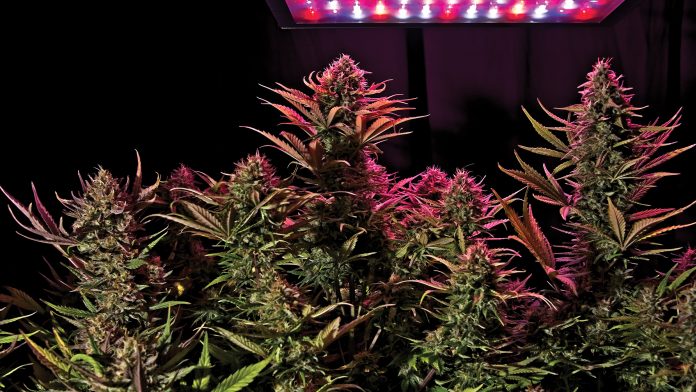
Freedom for your cannabis crop cycle, cost savings on energy & mitigating environmental impact – explore how technological advancements have opened up new options for indoor growth lighting.
As the cannabis market grows and the range of medical products available offer patients more choice, cannabis crop yield and quality are of increasing importance. The medical cannabis market has now opened up for higher industry production standards to ensure quality medical products and consistent cannabinoid profiles – which depend on good lighting and standardised growing techniques.
The bud of the plant is the main source of CBD and THC, therefore lighting is one of the most important factors when producing high quality medical cannabis – effecting morphology and cannabinoid production in the plant. The light quality and intensity are important factors when cultivating higher cannabis crop yields as well as being vital for temperature control.
For years, high-pressure sodium (HPS) lights have been the industry standard – but advances in lighting technology have revealed new choices for cultivators. This means they can scale up without needing to invest in large quantities of different kinds of lights for different stages of the growing process. Nor do they need to rely on the sun or weather conditions for high quantity and quality yields – high tech lighting can provide optimal growing conditions all year round, both day and night.
Aside from needing the right kind of lighting for optimal growing conditions – cultivation can be a costly process, and different lights can have an impact on energy usage. Automation can also be a vital factor when scaling up, so any equipment that offers this function can be of huge benefit to the medical cannabis industry.
So, what lights are leading the medical cannabis market today and how do they contribute to quality medical buds and efficient production?
Traditional lighting vs smart lighting
Ceramic Discharge Metal Halide (CDM), Metal Halide (MH), HPS lights (all high intensity discharge lights) and fluorescent lights have traditionally been used in the industry for indoor growing during different stages of the growing process. These lights range in colour – MH lights produce a bluish light and can be used all the way through to vegetation, whereas HPS lights produce a redder light which is good for encouraging bud production.
High Intensity Discharge (HID) lights are wildly efficient in terms of light availability but are very costly to run. They have been a favourite of cultivators worldwide until recently, as light-emitting diodes (LED) are fast becoming a more popular choice due to the advancement of technology.
Full-spectrum LED’s provide a scalable solution for the high industry standards sought after by medical cultivators. Growers will no longer need different bulbs for different stages of the growing process. LED bulbs can be better for heat as they often come with built-in cooling systems so can be put much closer to the plants without damaging them.
During the vegetation stage fluorescent lights prevent small plants from burning under the heat of higher intensity lights. However, past the vegetation stage they do not offer enough Photosynthetic Active Radiation (PAR) for the plants, which means smaller yields with lower quality buds. For the large-scale medical cultivator this is insufficient for producing buds that are suitable for the market. LED’s also offer more efficiency when it comes to PAR meaning growers can get more light usage out of the fixtures. So, depending on the capacity of the circuit used, LED’s are the most efficient for cost relative to the amount of usable light produced by the bulbs.
Benefits for controlling photoperiod
LED’s are very much a part of the ‘smart lighting’ revolution and come with auto functions either built-in or separately, making it much easier for cultivators to control lighting cycles.
Cannabis is a plant that is photoperiod sensitive – vegetation requires 16 to 18 hours of light per day whereas triggering flowering takes 12 hours. This is certainly not possible all year round in the natural world depending on where the cannabis is being grown. LED automated lighting can provide large-scale cultivators with a great option for these lighting on-off periods, so the medical cannabis grower has more freedom for their cannabis crop cycle – being able to alter the amount of red light for flowering at a time to suit their needs.
Environmental impact of lighting
Growing outdoors using the light of the sun is of course the best way to minimise impact on the environment and growing in greenhouses takes much less energy than indoor growing. However, when it comes to indoor crops, traditional high-intensity lighting can use huge amounts of energy – leaving a big carbon footprint. During the vegetation stage these traditional high-powered lights can be left on for more than 18 hours a day. A 2012 report found that energy usage from indoor crops in America equated to 1% of the national energy usage.
Although a little more expensive upfront, LED’s are much more efficient in their energy usage – allowing large-scale medical cannabis cultivators the ability to grow at half of the electricity cost, as well as drastically reducing the carbon footprint left by cultivation.
Aside from these environmental benefits, LED’s can last anywhere from 6,000 to 50,000 hours, so do not need to be replaced often as often. The cooling feature also means less extraction fans – saving further on energy costs.
Reference
Please note, this article will appear in issue 10 of Health Europa Quarterly, which will be available to read in July 2019.



















